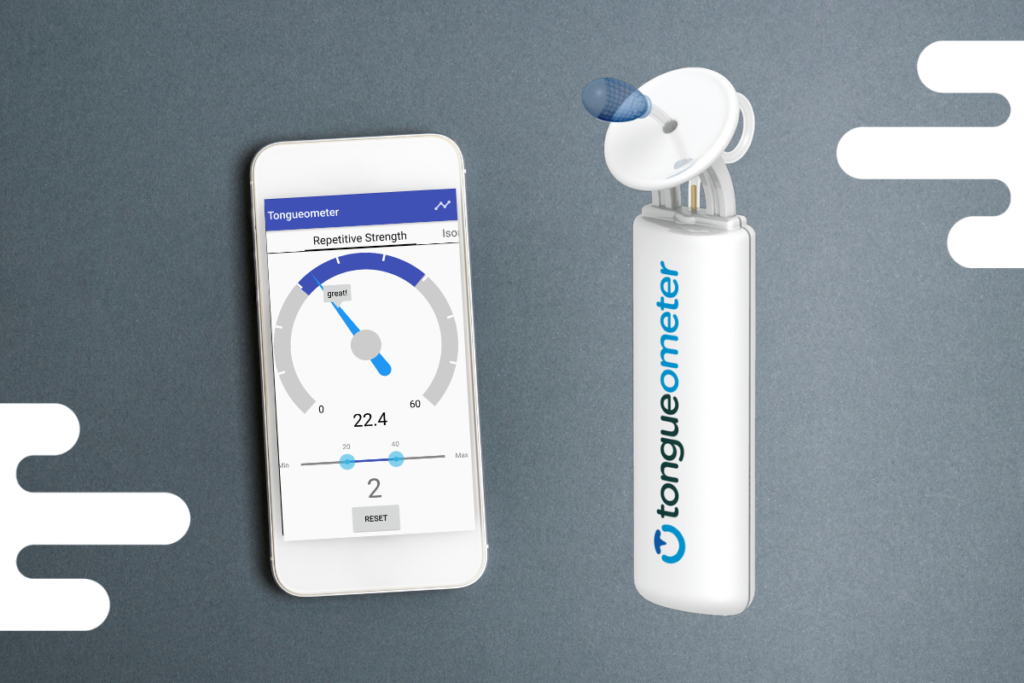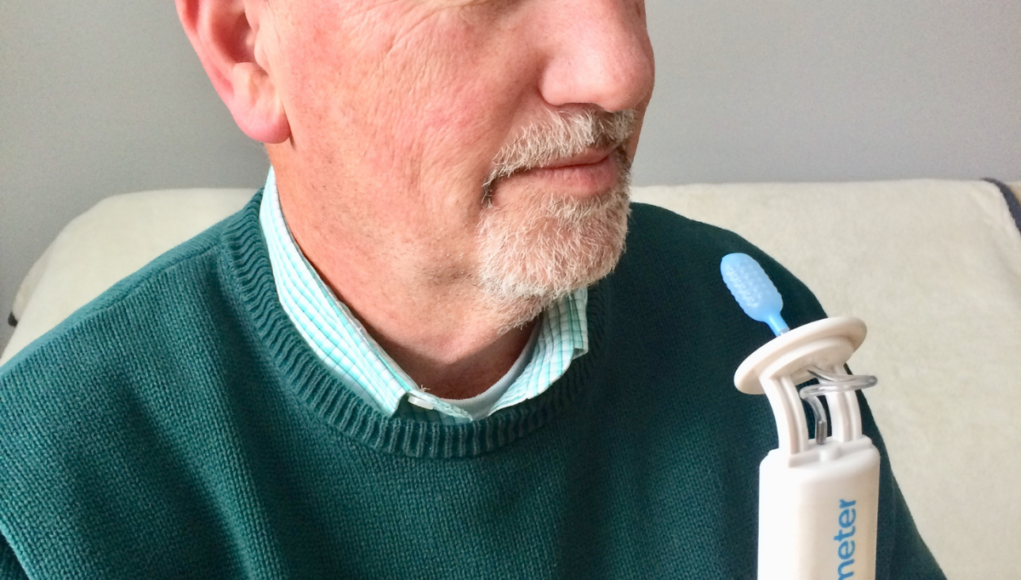This is a sponsored post for the Tongueometer. For more information, please visit www.e2scientific.com.
Why is Tongue Strength Important?
The tongue plays a major role in swallowing, including mastication, bolus formation and manipulation, and propulsion of the bolus into the pharynx. Decreased tongue strength has been associated with:
- Poor bolus formation1
- Premature bolus loss1
- Decreased tongue-to-palate contact2,3
- Prolonged oral transit time4
- Aspiration11
Tongue strength has been studied in a variety of patient populations including stroke, head and neck cancer, Parkinson’s, and acquired brain injury. Patients with acute and progressive neurologic impairments experience a high rate of dysphagia.5 In these patients, tongue weakness may contribute to impaired bolus control and/or transit, resulting in decreased efficiency. Tongue weakness may also contribute to premature spillage or impaired swallow timing, resulting in safety concerns such as penetration and aspiration.
Why is Measuring Tongue Strength Important?
Having an objective way in which to measure tongue strength can help the clinician determine if tongue strength is reduced compared to that of healthy adults, providing a therapy target. Objective measurements also allow the clinician to measure changes in tongue strength over time and determine appropriate modifications throughout the patient’s treatment.
What are the Potential Benefits of Tongue Strengthening?
Some research has shown that tongue strengthening exercises can help improve swallow safety and dietary intake for patients with oropharyngeal dysphagia. However, recent well controlled clinical trials have shown variable results in changes to swallow physiology and airway safety, despite demonstrating increases in tongue strength.6 Overall, the impact of device-facilitated tongue strengthening exercise is mixed. More research, particularly prospective, randomized controlled trials with large homogenous patient samples are needed to better support the use of device-facilitated tongue strengthening in various clinical populations.
Potential benefits shown in the literature suggest that, in some clinical populations, tongue strengthening exercise may:
- Increase swallow pressure7
- Decrease oral residue8
- Decrease pharyngeal residue6
- Decrease penetration-aspiration scale score (PAS)8
- Improve swallow timing8
- Improve patient reported outcomes, such as quality of life8
What is the Tongueometer™ Device?
The Tongueometer is a biofeedback device that objectively measures tongue strength and endurance. It can also be used to measure lip strength and endurance. The Tongueometer device pairs to a free downloadable app on one’s phone/tablet that shows, stores, and can send exercise data. Using an air-filled bulb, the user applies pressure to the bulb by pressing it to the roof of the mouth using the tongue. The bulb tubing can be adjusted to exercise the anterior, posterior, and even lateral aspects of the tongue.
The app includes four modules; two for assessment, two for exercise:
- Maximum Strength: assessment module designed to measure the maximum pressure, in kilopascals (kPAs), that the user can apply by pressing the bulb against the roof of the mouth with the tongue.
- Maximum Endurance: assessment module designed to measure the maximum length of time, in seconds, that a user can maintain a tongue pressure within a set pressure range of his or her maximum pressure.
- Repetitive Strength: exercise module designed to increase tongue strength. Based on a user’s maximum strength, a clinician can determine and set an appropriate target pressure range, which is highlighted on a visual meter, in addition to determining the appropriate number of repetitions for that user. The application displays visual biofeedback in real-time as the user applies pressure to the bulb and records the number of successful repetitions on the screen.
- Isometric Endurance: exercise module designed to increase tongue endurance. Based on a user’s maximum strength, the clinician can determine an appropriate target pressure range and, based on the user’s maximum endurance, set the length of time for which a user should attempt to maintain that pressure. The application displays a stopwatch and meter for visual biofeedback, in addition to showing the number of successful repetitions on the screen.

Why Use the Tongueometer Device?
The Tongueometer device can be used as part of an initial assessment to help determine if tongue weakness is a factor that may be contributing to a patient’s dysphagia. The device can also be used to monitor changes in tongue strength over time, as part of a rehabilitation program to increase tongue strength or endurance, or even prophylactically. There is emerging research that supports the use of tongue strengthening exercise in older individuals to prevent age-related tongue weakness.9
Preliminary findings show strong concurrent validity across anterior, posterior, and swallowing pressure measures when compared to the Iowa Oral Performance Instrument (IOPI), which is considered the current gold-standard device for lingual manometry.10
The top reasons for choosing the Tongueometer as part of a device-facilitated tongue strengthening treatment program:
- Affordability: the goal of E2 Scientific Corp, the Tongueometer device manufacturer, was to produce an affordable, accessible biofeedback tongue strengthening device. Currently, the device is available for under $300, which is a fraction of the cost of most biofeedback tongue strengthening devices on the market.
- Modifiability: the Tongueometer device allows users to easily modify the exercise parameters to best meet their needs.
- Biofeedback: the Tongueometer device provides visual biofeedback and displays assessment and exercise performance results in a user-friendly format within the app. Users also have the option of turning on auditory and tactile (vibration) feedback.
- Data Analysis: the Tongueometer application stores all assessment and exercise data. With the user’s explicit permission, all data can be shared with the click of a button in the form of a .csv file through email, DropBox, etc. For example, a patient using the device as part of his/her home rehabilitation program can email their Data Report to their clinician from home to determine appropriate exercise parameter modifications. There is a free “Dashboard Report” template available on the E2 Scientific website into which the Data Report can be copied that provides a graphical display of changes in tongue strength, endurance, and adhere to an exercise regimen over time.
In conclusion, device-facilitated tongue strengthening exercise has shown to increase tongue strength and may benefit patients with lingual weakness in improving aspects of swallowing efficiency and safety.
For more information on the Tongueometer, please visit www.e2scientific.com
References
1. Robbins J, Kays SA, Gangnon RE, Hind JA, Hewitt AL, Gentry LR et al. The effects of lingual exercise in stroke patients with dysphagia. Arch Phys Med Rehabil. 2007;88:150–158.
2. Kim, H. D., Choi, J. B., Yoo, S. J., Chang, M. Y., Lee, S. W., & Park, J. S. (2017). Tongue‐to‐palate resistance training improves tongue strength and oropharyngeal swallowing function in subacute stroke survivors with dysphagia. Journal of oral rehabilitation, 44(1), 59-64.
3. Hirota N, Konaka K, Ono T, Tamine K, Kondo J, Hori K et al. Reduced tongue pressure against the hard palate on the paralyzed side during swallowing predicts dysphagia in patients with acute stroke. Stroke. 2010;41:2982–2984.
4. Lee, J. H., Kim, H. S., Yun, D. H., Chon, J., Han, Y. J., Yoo, S. D. & Soh, Y. (2016). The relationship between tongue pressure and oral dysphagia in stroke patients. Annals of rehabilitation medicine, 40(4), 620.
5. Clave P, Rofes L, Carrion S, et al. Pathophysiology, relevance and natural history of oropharyngeal dysphagia among older people. Nestle Nutr Inst Workshop Ser. 2012;72:57–66
6. Steele, C. M., Bayley, M. T., Peladeau-Pigeon, M., Nagy, A., Namasivayam, A. M., Stokely, S. L., & Wolkin, T. (2016). A randomized trial comparing two tongue-pressure resistance training protocols for post-stroke dysphagia. Dysphagia, 31(3), 452-461.
7. Park, J. S., Kim, H. J., & Oh, D. H. (2015). Effect of tongue strength training using the Iowa Oral Performance Instrument in stroke patients with dysphagia. Journal of physical therapy science, 27(12), 3631-3634.
8. Robbins, J., Kays, S. A., Gangnon, R. E., Hind, J. A., Hewitt, A. L., Gentry, L. R., & Taylor, A. J. (2007). The effects of lingual exercise in stroke patients with dysphagia. Archives of physical medicine and rehabilitation, 88(2), 150-158.
9. Rogus‐Pulia, N., Rusche, N., Hind, J. A., Zielinski, J., Gangnon, R., Safdar, N., & Robbins, J. (2016). Effects of device‐facilitated isometric progressive resistance oropharyngeal therapy on swallowing and health‐related outcomes in older adults with dysphagia. Journal of the American Geriatrics Society, 64(2), 417-424.
10. Mohsin, N., Guastella, R., Oppedisano, S. & Namasivayam-MacDonald, A.M. (2021). Determining the validity of the Tongueometer in comparison to the Iowa Oral Performance Instrument. Poster presentation at the 2021 Dysphagia Research Society Annual Meeting. March 11, 2021. Virtual Conference.
11. Butler, S. G., Stuart, A., Leng, X., Wilhelm, E., Rees, C., Williamson, J., & Kritchevsky, S. B. (2011). The relationship of aspiration status with tongue and handgrip strength in healthy older adults. Journals of Gerontology Series A: Biomedical Sciences and Medical Sciences, 66(4), 452-458.





